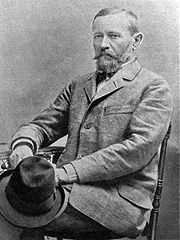
Adolf Dygasinski
Encyclopedia

Poland
Poland , officially the Republic of Poland , is a country in Central Europe bordered by Germany to the west; the Czech Republic and Slovakia to the south; Ukraine, Belarus and Lithuania to the east; and the Baltic Sea and Kaliningrad Oblast, a Russian exclave, to the north...
novelist, publicist and educator. In Polish literature
Polish literature
Polish literature is the literary tradition of Poland. Most Polish literature has been written in the Polish language, though other languages, used in Poland over the centuries, have also contributed to Polish literary traditions, including Yiddish, Lithuanian, Ukrainian, Belarusian, German and...
, he was one of the leading representatives of Naturalism
Naturalism (literature)
Naturalism was a literary movement taking place from the 1880s to 1940s that used detailed realism to suggest that social conditions, heredity, and environment had inescapable force in shaping human character...
.
During his literary career, Dygasiński wrote several short stories and novels. Since 1884 his works were being published in book-form and enjoyed considerable success. They were translated into Russian and German. In 1891 Dygasiński went on a trip to Brazil on a trail of Polish emigrants from Partitioned Poland. He produced a series of letters describing the tragic fate of Polish emigrees in South America. In the following years Dygasiński maintained a position of a tutor and coach for numerous wealthy landowning families. Late in life he settled in Warsaw
Warsaw
Warsaw is the capital and largest city of Poland. It is located on the Vistula River, roughly from the Baltic Sea and from the Carpathian Mountains. Its population in 2010 was estimated at 1,716,855 residents with a greater metropolitan area of 2,631,902 residents, making Warsaw the 10th most...
, where he died on June 6, 1902, and was buried at the local Powązkowski Cemetery.
Works
In his work Dygasiński often focused on topics of rural life and residents of small towns, highlighting the common fate of both, human and animal communities. Some of his most important work include:- Wilk, psy i ludzie (Wolf, dogs and humans; 1883)
- Ogólne zasady pedagogiki dotyczące wykształcenia umysłu, uczuć, moralności i religijności (General principles of teaching in the education of mind, emotions, morality, and religion; 1883)
- Na pańskim dworze ( 1884 ) At the court of the Lord ( 1884 )
- Głód i miłość (Hunger and Love; 1885)
- Na warszawskim bruku (On the streets of Warsaw, 1886)
- Nowe tajemnice Warszawy (New secrets of Warsaw; Vol. 1-2, 1887)
- Właściciele (Owners; 1888)
- Beldonek (Beldonek; 1888)
- Jak się uczyć i jak uczyć innych (How to learn and how to teach others; 1889)
- Pan Jędrzej Piszczalski (Mr. Jędrzej Piszczalski; 1890)
- Na złamanie karku (At breakneck speed; 1893)
- Gorzałka (Booze; 1894)
- Żywot Beldonka (Beldonka's Life; 1898)
- As (As; 1896)
- Zając (Hare; 1900)
- Listy z Brazylii (Letters from Brazil; 1900)
- Margiela i Margielka (Margiela and Margielka; 1901)
- Gody życia (Mating Life; 1902)
See also
- History of philosophy in Poland
- List of Poles

